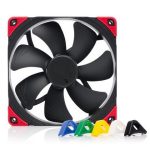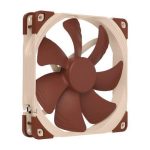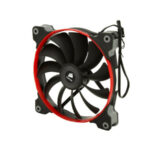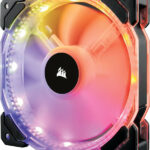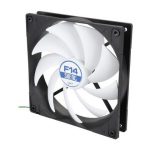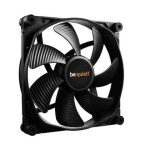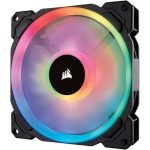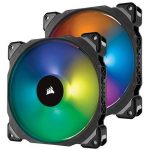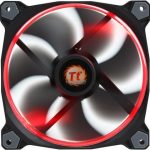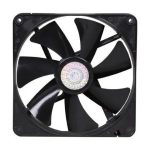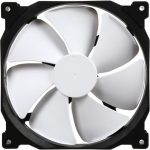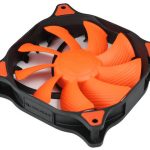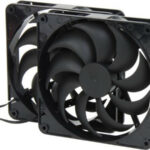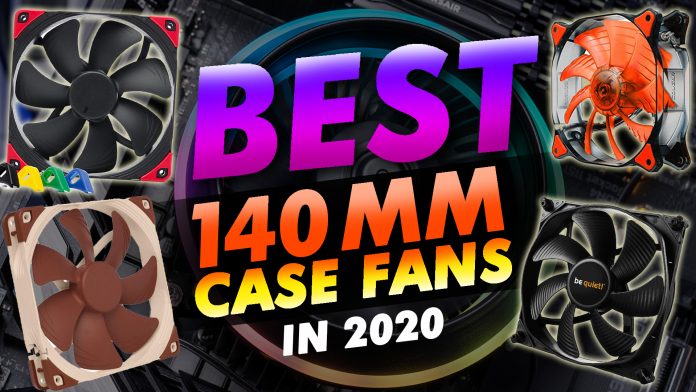
It’s either you’re here to find case fans for your first PC build or looking to make an upgrade. Either way, if you’re struggling to find the best 140mm case fan you can get in 2020, you’re in for a treat!
In this article, we’ve left no stone unturned to come up with a list of the best case fans for various setups and needs.
Having that said, let’s look at what we’ve come up with
Are All 140mm Case Fans the Same?
Just to clear things out: no, not all 140mm case fans work the same.
You will find that some 140mm case fans work best when installed on radiators as well as 140mm case fans that work best when used as an intake or an exhaust fan.
The main thing that makes these fans different from each other is the design of the fins. Intake and exhaust fans need to move as much volume of air without being interrupted to maximize airflow potential. On the other hand, high static-pressure fans work best if there is an obstruction in the airflow lane by either a hard drive bay or anything at all.
To learn more about the difference between these two fin types, check our in-depth buying guide found after the list of the best 140mm case fans below.
Best 140mm Case Fans: An In-Depth Look
1. Noctua NF-A14 PWM chromax.Black.swap
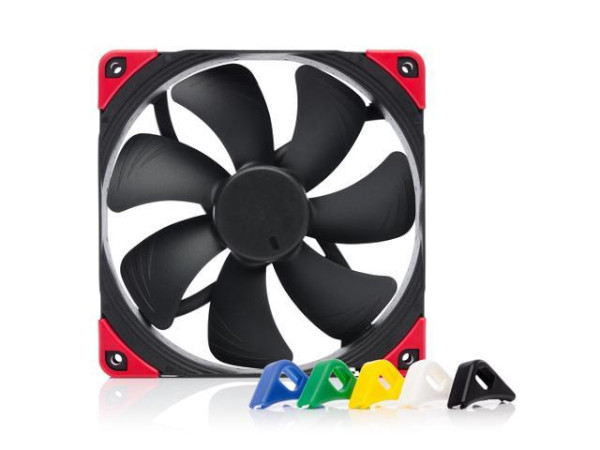
Tech Specs:
Size: 140mm x 140mm x 25mm | Connection Type: 4-pin PWM | Rotational speed: 1500 RPM | Noise Level: 24.6 dB(A) | Airflow: 82.5 CFM | Bearing type: SSO-Bearing
Noctua is a name computer enthusiasts trust and relies on when it comes to air cooling. It’s “beige and brown” color has been its trademark even since. But at the same time, it’s also been among its drawbacks as users wish they can purchase it in a different color to match their theme.
After so many years, Noctua has finally listened to its consumers and developed the Chromax product line. In this case, the NF-A14 PWM has the chromax.Black.swap version for all you builders looking to get a 140mm case fan.
The box still has a brown and black accent with the Noctua logo accompanied by the model name found at the top left corner.
Inside you’ll see the Chromax.black.swap fan next to the six anti-vibration rubber pads that come in different colors (black, red, green, blue, white, and yellow). Unlike the rest of its competition in the market, you can swap the colors anytime.
In terms of performance, it’s very much identical to its beige and brown versions in every aspect. They also feature the same SSO2 bearing technology, so there should not be any significant difference.
Thanks to it’s PWM connection type; you can adjust the fan curve on the fly, perfect if you’re an advanced builder looking to maximize your airflow potential.
Overall, Noctua’s product-lines are reliable and worth considering. If you’re aiming to get the best 140mm fan for your computer, Noctua NF-A14 is the best on the list. Do note that this can be a little bit pricey, but considering how it performs, it’ll be worth it.
On the other hand, if this sounds too loud for whatever reason, then the next product from Noctua might be the perfect product for you.
2. Noctua NF-A14 ULN
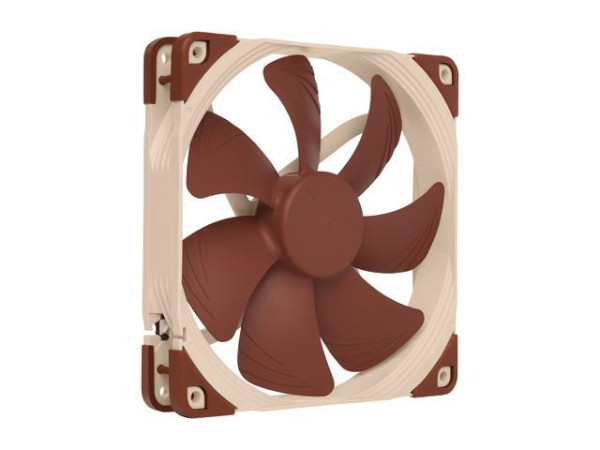
Tech Specs:
Size: 140mm x 140mm x 25mm | Connection Type: 3-pin PWM | Rotational speed: 800 RPM | Noise Level: 11.9 dB(A) | Airflow: 79.8 CFM | Bearing type: SSO-Bearing
Of all the quiet case fans in the market, you’ll definitely find this at the top of the list. It’s from Noctua, so you can ensure this belongs to the premium quality.
The ULN stands for Ultra-Low Noise, which explains why it only has a noise level of 11.9 dBA. But the silent feature is defined by its low rotational speed of only 800 RPM. Considering all that and you only get a 79.8 CFM– that’s only slightly lower than the potential of Noctua’s NF-A14 PWM fans!
Now, you might be wondering: Why would I need this low RPM case fan when the rest of the 140mm fans on the list excels significantly in terms of overall performance?
Not all systems need over-the-top cooling performance, especially if you’re only going to use it for office setup. Moreover, a computer in an office setup needs to be as silent as possible to limit distractions.
Since office computers don’t perform as intense as gaming setups, they don’t need a substantial amount of airflow to keep the entire system cooled. This is why the Noctua NF-A14 ULN is the perfect 140mm case fan for this setup.
With the anti-vibration pads and the improved SS02 bearing, it will perform outstandingly without being too noisy.
3. Corsair Air Series AF140
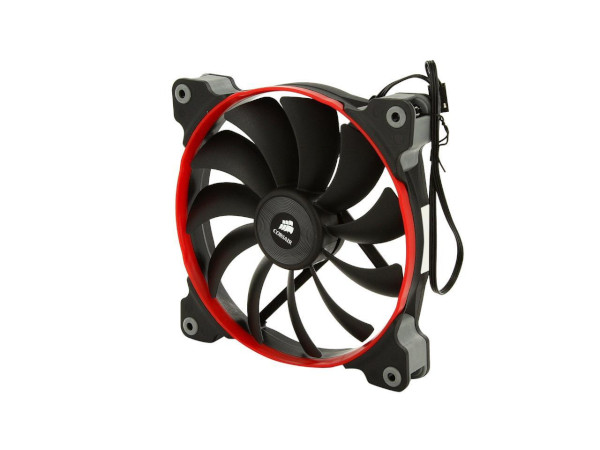
Tech Specs:
Size: 140 mm x 140 mm x 25 mm | Connection Type: 4-pin | Rotational speed: 1150 RPM | Noise Level: 24 dBA | Airflow: 67.8 CFM | Bearing type: Sleeve bearing
The Corsair Air Series AF140 is one of the best-looking and performing case fans on this list. It comes in four color options (purple, white, blue, and red) that should seamlessly complement the theme of your gaming rig.
Unlike generic fans you would find on the market, the AF140 doesn’t have holes drilled in them to accommodate lighting. Instead, it has a custom-molded blade design and a sleeved-bearing system to ensure optimal airflow and minimal noise without compromising aesthetics.
The Air Series AF140 comes in a simple package with a clear window to showcase the fans. Like most case fans, it has a black plastic frame with semi-transparent blades. Everything you need is provided in the box, including black screws to match the color of your chassis.
The LED lights are installed on the corner of the frames, parallel to the plastic engine support bars.
The Air Series AF140 features a hydraulic bearing, which is technically a sleeve bearing with both bearing and axle immersed and sealed in a fluid. The axle and the sleeve do not come in contact with each other as the liquid interferes between them.
Overall, the Air Series AF140 is a significant upgrade if you are currently using generic case fans.
4. Corsair HD Series HD140
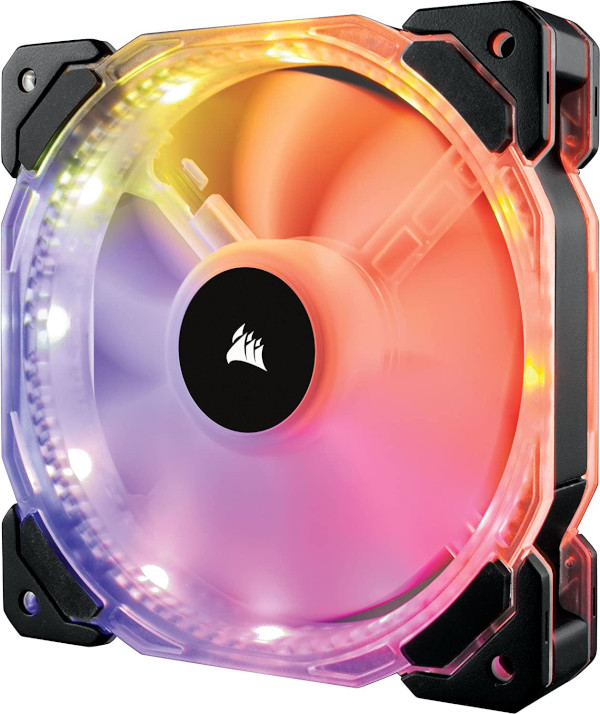
Tech Specs:
Size: 140 mm x 25 mm x 140 mm | Connection Type: 4-pin | Rotational speed: 600 – 1350 +/- 10% | Noise Level: 28.6 dBA | Airflow: 74 CFM | Bearing type: Hydraulic
Another product from Corsair that you should consider is the Corsair HD Series HD140.
The HD140 allows you to set and adjust the lighting to modes like fade colors, breathing, or blinking. You can also customize each of the 12 RGB LEDs to achieve personalized lighting effects.
The HD140 comes with the Lightning Node Pro, a three-button controller that lets you access and cycle through various lighting effects. You can also adjust the speed of the fan using the same controller. To power the Lighting Node Pro, you need to connect it to an available internal USB 2.0 header. All the instructions for setting up the controller are in the user manual.
The HD140 has a PWM control range between 600-1350 and features a high static pressure design, allowing it to work well even if there is resistance from inside the case. If you are running a radiator, this fan is an excellent option. Even when it runs at full speed, it is resistive to vibration and turbulence for whisper-quiet performance.
Included in the package are the following:
- 2 x HD140 RGB LED 140 mm PWM fans
- 1 x Fan RGB LED controller
- 1 x Six port RGB LED hub
- 8 x Mounting screws
- User manual
Is the HD140 the right case fan for you? That depends. If you’re looking to upgrade your setup to achieve a more personalized theme, it is definitely a worthy investment. However, since it is a little more expensive than entry-level case fans, budget builders might be turned off.
5. ARCTIC F14 Silent
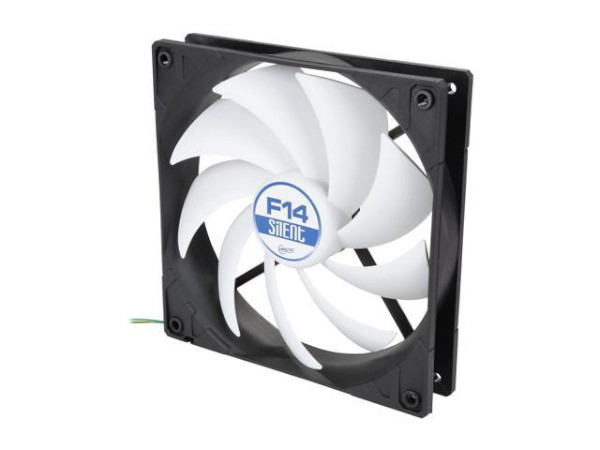
Tech Specs:
Size: 140mm x 140mm x 27mm | Connection Type: 3-pin socket | Rotational speed: 800 RPM | Noise Level: 22.5 dB(A) | Airflow: 46 CFM | Bearing type: Fluid dynamic bearing
The Arctic F14 Silent is a perfect alternative for people who are looking for a silent fan that’s significantly cheaper than the Noctua ULN. Due to its excellent performance at a relatively low value, people have found this fan as a decent option.
It’s best to give you an idea that this isn’t a 4-pin PWM fan, which means there’s no need to make complicated fan curve adjustments and whatnot. All you have to do is hook this up to your motherboard and let your motherboard make all the adjustments.
It’s significantly cheaper than the Noctua ULN above, but it does feature a decent airflow rating of 46 CFM. Despite using a fluid dynamic bearing type, it can still go as loud as 22.5 dB(A).
This is perfect for people who are on a budget. With innovative design, it offers excellent ventilation capability without being too loud, compared to the rest of its competitions in the budget category.
Due to the lack of RGB, this may not look aesthetically pleasing inside your tempered PC case. However, you can rely on this affordable silent 140mm case fan until your next upgrade.
6. be quiet! Silent Wings 3
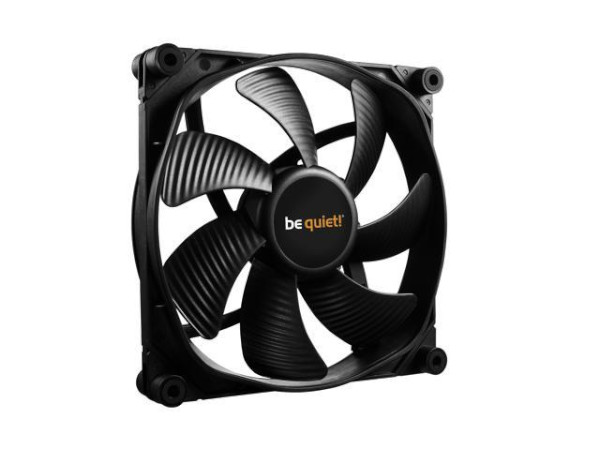
Tech Specs:
Size: 140mm x 140mm x 25mm | Connection Type: 4-pin PWM | Rotational speed: 1000 RPM | Noise Level: 15.5 dB(A) | Airflow: 59.5 CFM | Bearing type: Fluid Dynamic Bearing
This is another extremely silent case fan that does output quite a lot for how much it cost. You see, the fins feature a not-so-regular pattern that actually functions in a way to optimize airflow. The curves and across the blade allows air to move freely so the fan can achieve optimum performance without being too noisy.
If you also look closely, you can see that the corners of the intake side have a “funnel-shaped air inlet” that takes air in more effectively. Also, the fan’s corner mounts have a rubber core to keep it from vibrating too much. Both of these designs are why this only has a very low noise level of 15.5 dB(A).
Compared to Noctua’s beige and brown colors, this has a black color and a design that goes well with most setups and PC themes. If you are unsure which between the two is for you, ask if aesthetics matter to you, because this will be the better option if your answer is yes.
On the other hand, the Noctua will be the better option if you value performance over aesthetics. Either way, both perform excellently in the cooling department, so you shouldn’t go wrong.
Another thing that makes this worth considering is its six-pole electric motor mechanics that mainly consumes less power even though it has a slightly higher rotational speed of 1000 RPM.
Since it has a 4-pin connection, you will be able to make fan curve adjustments at will. Honestly, a 4-pin connection is always lovely to have when investing in a case fan, but only when you’re interested in making specific fan curves to maximize airflow potential inside your case.
You’ll also notice inside the packaging that the DC voltage control version comes with a 3-way splitter: the 5V, 7V, and the 12V adapters. What’s more surprising than that is the fact that this doesn’t have any MOLEX connectors!
Lastly, this will last long since it uses fluid dynamics bearing proven to be reliable for long-term use.
7. Corsair LL140
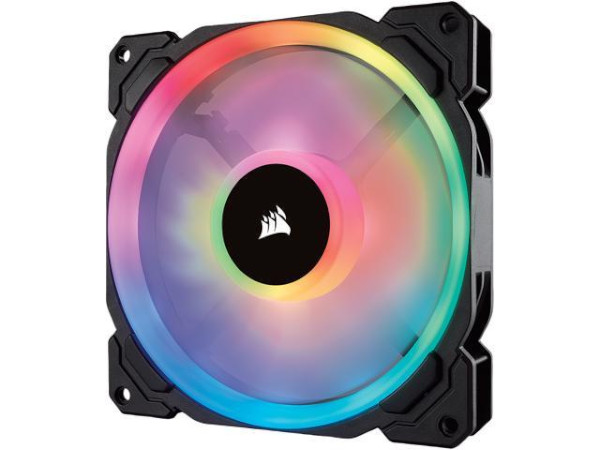
Tech Specs:
Size: 140mm x 140mm x 25mm | Connection Type: 4-pin PWM | Rotational speed: 1300 RPM | Noise Level: 25 dB(A) | Airflow: 51.5 CFM | Flow Type: Static Pressure | Bearing type: Hydraulic
Compared to the first two products we’ve covered above, this looks like it’s more inclined towards aesthetics than performance. However, Corsair is also a brand named that computer enthusiasts and professionals trust when it comes to quality and performance.
In the case of the Corsair LL140, it isn’t all about lighting. So let’s cover everything about its performance first before we cover the details of its lighting feature.
The fans are really quiet even when they’re running at max RPMs. If you use six of these, you’ll notice that your system will be running at a cooler temperature. This is why you’ll rarely see them run over 1250 RPM. And because it’s using hydraulic bearings, you can assure they perform fine– just not as good as our top pick in terms of airflow.
But because the fans work best when grouped into three or six, the airflow is actually good. Besides, it’s lighting feature is it’s selling point after all. So, let’s talk about that.
To ensure that all the fans work perfectly in synchronization, there’s a fan hub capable of syncing up to six fans through a SATA connection. This then goes to a Lighting Node PRO controller that can hold up to two fan hubs or a total of twelve fans.
Do note that the lighting effects will play according to the order the fans are plugged in, so be mindful of where you connect them to avoid confusion when setting up the lighting system via Corsair’s proprietary software.
The idea of using these hubs mainly benefits users that have PC cases with tempered glasses. Otherwise, it defeats the purpose of showing off. Ideally, you’ll only want to get these if you wish to fill all your case fan slots.
Overall, it performs great as a group, but if you need only a couple, you’re better off getting the first two 140mm case fans above.
8. Corsair ML140
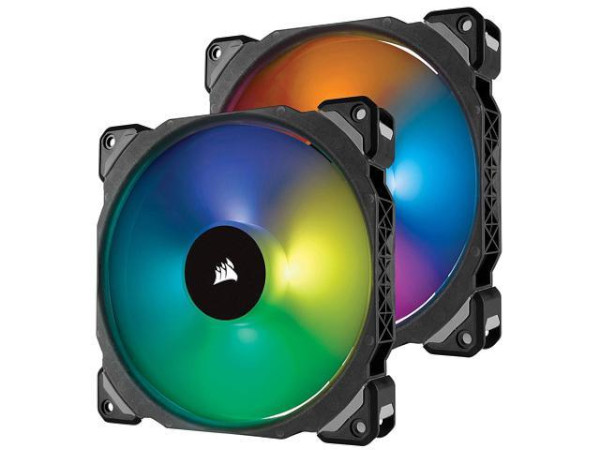
Tech Specs:
Size: 140mm x 140mm x 25mm | Connection Type: 4-pin PWM | Rotational speed: 2000 RPM | Noise Level: 37 dB(A) | Airflow: 97 CFM | Flow Type: Static Pressure | Bearing type: Magnetic Levitation
This is another product from Corsair that’s way better than the LL140’s above. In terms of rotational speed and airflow, it easily outperforms in all aspects– except that it’s obviously louder when running at max speeds. However, thanks to the noise-dampening corners, this isn’t entirely loud at all when installed.
Unlike other case fans in the market, the ML140 has a design that follows a frictionless mechanism, making it capable of running crazy rotational speeds of up to 2000 RPM max. But to get the balance of low-noise and optimum airflow, you’ll want to set this to run around 1600 RPMs. After all, it has a PWM connection type so you can make fan curve adjustments.
The idea is it uses magnets to keep the fan locked in place without ever touching it.
Case fans are designed to either focus on pushing static pressure or high airflow, but the design of these fins are specifically made to balance both high static pressure and high airflow perfectly. This idea makes this perfect for every type of environment.
Honestly, replacing all of your case fans with these can be an expensive adventure, but these are considered premium fans in the market, and that makes them worth it.
Even though we wished that this has a full RGB feature, we’re still thankful that this comes in red, white, and blue.
9. Thermaltake Ring 14 Circular Case Fan
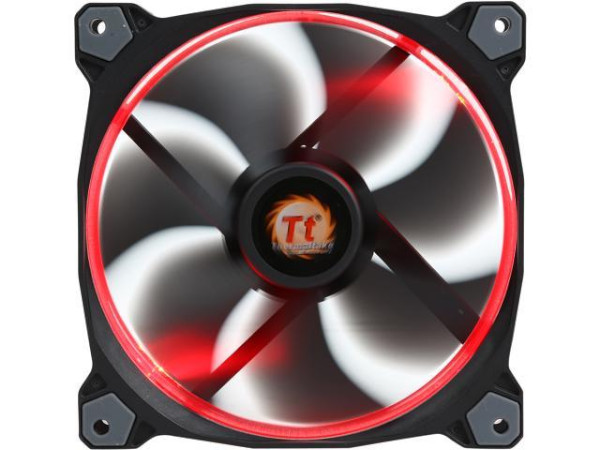
Tech Specs:
Size: 140mm x 140mm x 25mm | Connection Type: 3-pin | Rotational speed: 1400 RPM | Noise Level: 28.1 dB(A) / 21.1 dB(A) with LNC | Airflow: 51.1 CFM | Bearing type: Hydraulic Bearing
We included the Thermaltake Ring 14 Circular Case Fan because recent buyers have praised both the performance and quality of the case fan. To give you an idea of how well it performs, the airflow and the noise level is only slightly behind the Corsair LL140.
But in other areas, it falls way behind. For starters, this is a 3-pin fan, not a PWM fan. If you’re planning to make fan curves via your motherboard, you are better off considering other options on our list.
However, if you’re specifically looking for a reliable 140mm static pressure fan, this will be your best bet. The blade has a design that is more inclined towards giving off high static pressure, so it works absolutely great in areas where the air is blocked by other chassis parts like hard drive bays and whatnot.
This hydraulic bearing fan can deliver 51.1 CFM of static airflow, and even though it has a high 1400 RPM, it’s surprisingly quiet. People who are looking for a high-performance static pressure fan that’s also super-quiet will love this.
With an anti-vibration mounting system and a wide range of colors, this investment will probably be a great pick.
10. Cooler Master Silent Fan
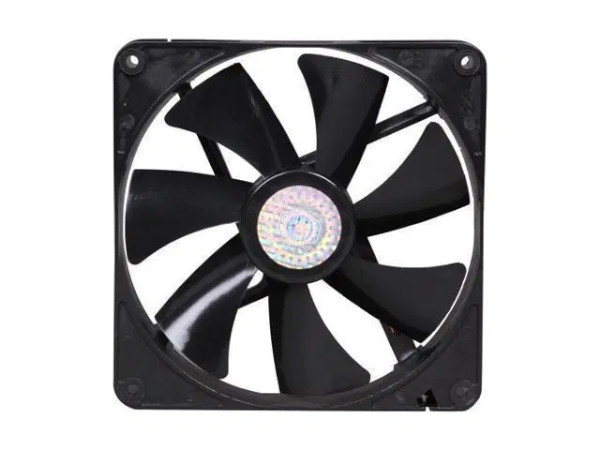
Tech Specs:
Size: 140mm x 140mm x 25mm | Connection Type: 3-pin | Rotational speed: 1000 RPM | Noise Level: 16 dB(A) | Airflow: 60.9 CFM | Bearing type: Sleeve Bearing
This didn’t get any special treatment in the aesthetics department, but it can compete effectively among the mid-range case fans. More precisely, it can move a decent amount of air with an airflow rating of 60.9 CFM without being noisy (16 dBA).
But this can be really noisy if you set it at max speeds so you might want to keep that in mind. To ensure you do not hear loud noises around the clock, just hook it up to your motherboard. You may not be able to control the fans, but at least the motherboard can adjust the fan speeds according to its needs.
Because it doesn’t have any RGB and other lighting features, it isn’t going to be as appealing as the Corsair and Thermaltake in this article. However, people on a budget looking for a PC case fan that can deliver a considerable volume of air without being too noisy may find this worth checking out.
The other silent fans on this list are great if you don’t do heavy work on your computer, but this one is ideal for users looking to do heavy workload on their computers such as gaming.
Overall, it doesn’t look aesthetically pleasing than the rest of its contenders, but the lack thereof is complemented with quality performance and output.
11. Phanteks PH-F140MP
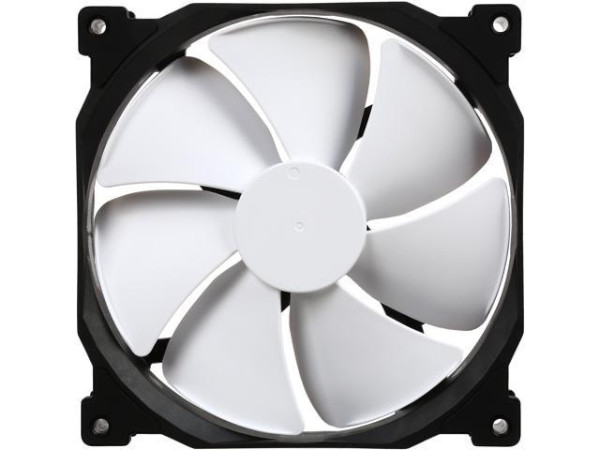
Tech Specs:
Size: 140mm x 140mm x 25mm | Connection Type: 4-pin PWM | Rotational speed: 1600 RPM | Noise Level: 25.3 dB(A) | Airflow: 68.1 CFM | Bearing type: UFB (Updraft Floating Balance) Bearing
Phanteks is another brand name that’s been doing well in making outstanding CPU air coolers. This explains why we have this included in our list of the best 140mm case fans.
Compared to most of the fans on the list, this is more inclined towards pairing it with a radiator and using it as an intake fan for its outstanding static pressure performance. While it’s true that they perform well if used as a case fan, it’s the design of the fan that makes them more ideal as radiator fans rather than case fans.
But let’s say you don’t really need a high airflow case fan because the front of your case has metals in the way. That’s when the Phanteks PH-F140MP comes into the picture. The improved MVB II blades generate better static pressure and produce better overall performance compared to the rest of its competitors.
The F140MP has a larger base size with a magnetic DC motor to keep resonance at bay, and to also achieve stable rotational performance. In short, Phanteks did an excellent job of designing the fan to gain a better airflow rate without being too noisy.
If you’re looking for a static pressure fan that you can use as an intake case fan, this might be the best on the list, especially if you’re on a budget.
12. Cougar Vortex CFV14HP
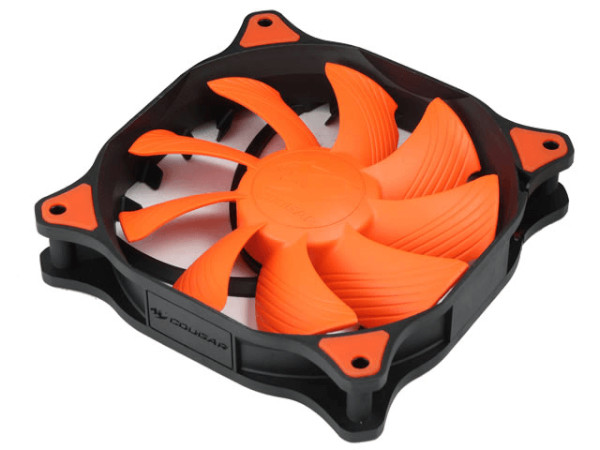
Tech Specs:
Size: 140mm x 140mm x 25mm | Connection Type: 4-pin PWM | Rotational speed: 1500 RPM | Noise Level: 17.9 dB(A) | Airflow: 70.5 CFM | Bearing type: HDB (Hydro-Dynamic Bearing)
Surprisingly, it’s only slightly louder than the Cooler Master Silent Fan. But in real-world difference, you almost can’t tell the difference. However, this does a perfect job of moving large volumes of air than the Cooler Master Silent Fan.
The fan curves can also be manually adjusted since it has a 4-pin PWM connector. But aside from that, it’s the bearing type that it uses that makes it attractive to the general consumer.
Even when you run this at max rotation, it doesn’t produce as much noise because of the HBD or hydrodynamic bearing. Moreover, the blade design and the built-in air-inlet is also what optimizes the aerodynamics. Together with the hydrodynamic bearing technology, it runs smoothly with almost no friction at all.
If you’re also going to look closely at the fins, these are rubbers to reduce vibrations. Mounting this won’t need any tools as it utilizes tool-less pins.
And unlike the rest of the 140mm case fans on the list, this still delivers optimum airflow and ensures optimum cooling temperature as it can move 70.5 CFM of air volume.
13. Rosewill 2-Pack Computer Case Fan 140 mm
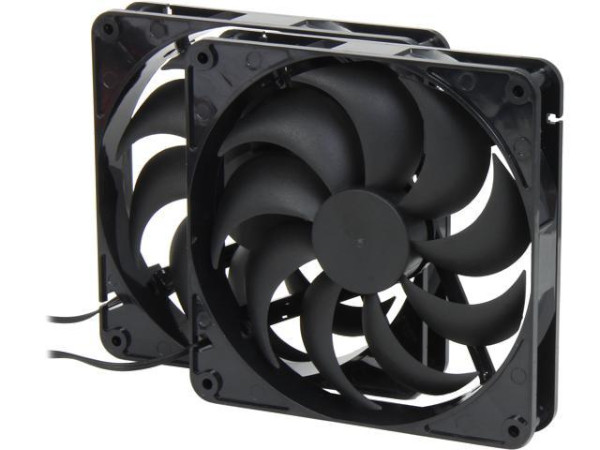
Tech Specs:
Size: 140 mm | Connection Type: 3-pin and 4-pin combo | Rotational speed: 1200 RPM | Noise Level: 23 dB | Airflow: 48.7 CFM | Bearing type: Fluid Dynamic
Rosewill is among the most trusted brand names in the budget case fan market, and their two-pack fan set is one of the best selling bundles online.
The fans in this set feature an 11-blade configuration operating at 1200 RPM ± 10% 0RPM. They employ a high-quality sleeve bearing to ensure durability and longevity. The fans have a noise level of only 23 dB for whisper-quiet operation even under load. Unfortunately, they vibrate when installed horizontally, especially when running at high RPM.
This fan set doesn’t have fancy lighting, but since it falls under the budget category, it is better to prioritize airflow than RGB.
Is It Really Important to Choose the Appropriate Case Fan for Your PC?
The short answer is: yes.
You see, computer hardware and components heat up as you use them, and depending on the usage will also be how heavy it can generate heat.
PC components have a relatively high temperature threshold. However, leaving them to work at high temperatures can significantly reduce its overall lifespan. With that in mind, it’s crucial to keep your PC case as cool as possible, so your components will last longer.
With the right case fan, you can continuously expel this heat buildup inside your PC to keep your computer components cool as they perform different tasks. But because there are different types of setups inside a computer chassis, you must choose a fan that best plays in these particular instances.
Since there are plenty of options in the market, it’s easy to get overwhelmed. This is why we also included a very detailed buying guide to ensure you’re guided when shopping for your computer’s 140mm case fan.
Why Should You Consider an Aftermarket Case Fan?
While built-in air cooling systems are beautiful, they don’t perform as effectively as an aftermarket case fan. This is why most PC builders simply buy aftermarket case fans to make sure that everything inside the PC case will be cooler.
Air cooling fans move the air inside the PC case when your PC components generate heat to keep them from overheating.
Leaving your heat to buildup inside your PC case can be harmful and dangerous to all your valued PC components. This is why you must consider a quality aftermarket case fan to cool your PC properly.
If you’re unsure whether you need to replace your stock fans, ask yourself the following:
- Is your PC generating more heat than it used to be even when idle?
- Are you planning to do some light overclocking?
- Are you looking to achieve the best performance boost?
- Are you worried about the longevity of your components?
- Do you just want to make your PC look great?
If your answer to those is a resounding yes, then read on! We’ve compiled a brief-but-detailed buying guide to help you choose the best case fan for your PC’s cooling needs.
What to Look for in a 140mm Case Fan?
Choosing which fan is perfect for your case can be intimidating. With all the specifications and marketing strategies that make each fan unique, you can easily get overwhelmed.
That’s why we went further to give you a brief-but-detailed buying guide to ensure your investment will not be wasted. So, when buying a 140mm case fan, make sure you check the following:
Static Pressure or High Airflow?
Case fans are designed for specific purposes, and there are are two types of fins that case fans have: Static Pressure or High Airflow.
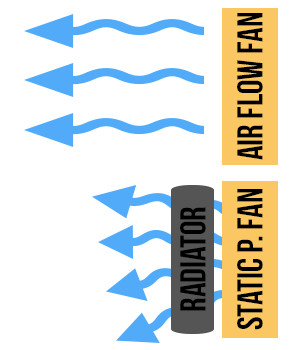
Static Pressure
This type of case fan pushes out the air more strongly than the airflow type, which makes them perfect in places where the air is obstructed. An excellent example of where static pressure fans excel over airflow fans are the following:
- CPU heat sinks
- Radiators
- Front case intake blocked by a hard drive bay
- Top case intake blocked by a hard drive bay
High Airflow
Compared to static pressure fans, high airflow works as its name suggests. As long as both sides of the fan are free from obstructions, these types of fans can push out large volumes of air.
This is why they’re great options if you’re looking for a case fan to put in the following:
- Front case intake
- Top case intake or outtake
- Back case outtake
Size
Sizes come in different sizes from 80mm to 250mm, but the most popular in the market are 80mm, 120mm, 140mm, and 200mm.

Most cases can fit a 120mm case fan, but some can fit 140mm ones. The reason why 140mm case fans are becoming more popular recently is that they’re more efficient and a tad quieter than 120mm because of their lower rotational speeds.
Basically, the smaller the fan size, the higher RPM it needs to push air compared to larger fans. This is why larger fans are preferred as they are quieter and more efficient at delivering enough airflow inside your PC case.
Check the Power Connection Type
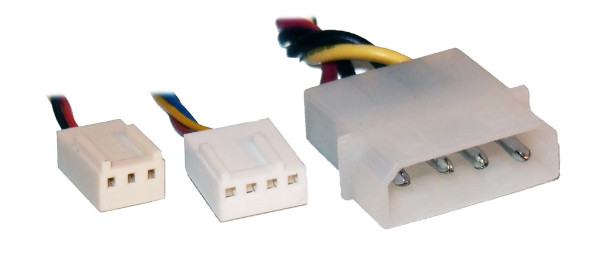
It’s also worth checking which power connection type the fan has. The most common type of connection is the 4-pin connection type, which goes directly to the motherboard connector.
The second most popular power connections are 3-pin types. It’s very similar to the 4-pin type connectors as you can still connect a 3-pin type fan to the 4-pin motherboard slots. If something makes this different, it’s the fact that it lacks one more pin.
The other popular connection type is Molex. Instead of going straight to the motherboard, this hooks directly to the power supply. What makes this different is that you can’t adjust its fan curve even with 3rd-party software.
Ideally, you want to make adjustments if possible, to maximize potential airflow. If directly connected to the power supply, the fan will run at maximum speeds at all times.
Check the Fan Speed (RPM)
Fans rotate when used and measured in revolutions per minute or RPM. On average, fan speeds are defined by the fan size and usually influence the overall performance.
Fans with smaller sizes run at higher RPMs to deliver a decent amount of air volume. Compared to larger fans, these are louder. On the other hand, larger fans run at lower RPMs but still deliver enough air volume.
Which is better boils down to which PC case you’re using as it could be too small or fit a 140mm case fan or too large for an 80mm fan.
How Loud Can the Fan Be?
Case fans can be really loud when they’re running at optimum speed, and they’re measured in dBA or decibels. The noise level of a case fan range as quiet as 10 dBA to as loud as 35 dBA.
To give you an idea of how soft or loud these numbers are, we’ve compiled a table below as reference:
| Decibel (dBA) Level | Equivalent Sound |
| 0 | Silence |
| 10 | Ticking watch |
| 20 | Rustling leaves |
| 30 | A whisper |
| 40 | Light rain |
| 50 | A quiet office |
| 60 | Normal conversation |
| 70 | Shower |
| 75 | Toilet flushing |
| 80 | Alarm clock |
How Much CFM Can the Fan Move?
A PC fan’s airflow is measured in CFM or Cubic Feet per Minute. This measures the volume of air that the fan pushes every minute.
Ideally, you will want a fan with a high CFM rate at a low speed or RPM. This will give you a fan that isn’t loud but delivers an adequate volume of air to keep your computer cool.
Know the Bearing Type
Another important thing you should check before choosing a computer fan is the type of bearing it’s using. Among the common types of bearing include sleeve bearing, hydrodynamic bearing, and ball bearing.
Of the three bearing types, the hydrodynamic bearing is the most durable type as it lubricates itself, unlike ball bearing and the sleeve bearing. But between the sleeve bearing and ball bearing, the ball bearing is the louder bearing type but also has a longer lifespan.
But Corsair has developed a new bearing type that uses magnets and levitation. These fans by Corsair are called Magnetic Levitation bearings. The combination of the fan’s rotor and bearing creates a magnetic field that doesn’t come in contact with the bearing, creating a frictionless mechanism to maximize performance.
Recap: Top 10 choices for the best 140mm case fan:
To get the right 140mm case fan for your needs, make sure you know reasonably well what specifics matter and what key points to check. Overall, we’ve covered 10 140mm case fans that work best for different situations.
Bottom line is you choose the following case fans if:
- Get the Noctua NF-A14 PWM chromax.Black.swap if you’re looking for the top 140mm case fan you can get in the market. It’s the best overall: from performance to different color selections.
- You will want to consider the Noctua NF-A14 ULN if you’re after a 140mm case fan that’s super silent. It basically performs just as good as the NF-A14 but it runs at lower RPMs and moves fewer air volumes, perfect for an office setup.
- If you’re looking for a cheaper alternative of a silent case fan, then the ARCTIC F14 Silent is your best bet. Just note that this doesn’t have a 4-pin PWM connection type.
- Get the be quiet! Silent Wings 3 if you’re looking for a cheaper alternative to the F14 that has a 4-pin PWM connector.
- If you’re looking for the most aesthetically pleasing 140mm case fan in the market, get the Corsair LL140. Combined with a complete set of Corsair fans, you get a decent airflow inside your case without being too noisy even if set to run over 1000 RPM.
- Alternatively, the Corsair ML140 is the better option if you’re looking for a Corsair fan that can achieve a rotational speed of 2000. But be minded that this doesn’t have full-RGB features like the LL140.
- You will want to get the Thermaltake Ring 14 Circular Case Fan if you’re looking for a budget case fan that can move a lot of air but don’t really need a 4-pin PWM for fan curve adjustments.
- Another budget alternative is the Cooler Master Silent Fan. It has a decent airflow rating but doesn’t have the 4-pin PWM.
- We recommend the Phanteks PH-F140MP if you’re looking for a budget high static-pressure case fan. Even though it uses a beautiful bearing type, it still produces a higher RPMs noise level.
- Lastly, the Cougar Vortex CFV14HP is the perfect investment if you’re all about high airflow and don’t care about the aesthetics department.
There you have it! Our complete list of the best 140mm case fans you can get as of July 2020. We hope you’ve learned a lot from this roundup! Which among the list you think is best for your needs?
Do you have any questions or suggestions? Tell us down in the comments!

